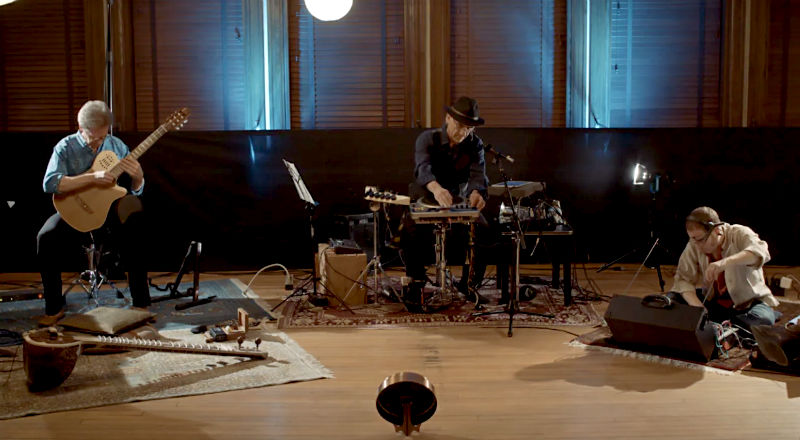Set the Controls for the "Heart" of the Sum: Robert Spalding Newcomb's music adds form to freedom

In "The Heart Sutra," one of Buddhism's most famous texts, there's a line that's often translated as "form is emptiness and the very emptiness is form."
I don't know if this particular sutra informed Robert Spalding Newcomb's structured improvisation "Dance of the Heart," but this long-form piece revels in the sort of free-flowing ambiance that feels simultaneously disembodied and corporeal. The music is an ode to freedom and that freedom helps shape the music's form.
Newcomb is a polymath -- computer expert, software developer, yoga teacher, stringed-instrument virtuoso (guitar, sitar) -- who combines all his talents to create modern music that's rooted in ancient traditions. "Dance of the Heart" is a reflection of that unique skillset, combining electronic percussion, synths, and effects-laden guitar.
"Dance of the Heart" premiered March 13, 2018, at the Riverside Arts Center in Ypsilanti -- you can watch the high-quality video here -- with Newcomb (guitar, sitar, laptop), Ken Kozora (electronic and acoustic percussion, iPad, trumpet), and Erik Gottesman (analog synthesizers, bio-sensors with EEG/shortwave/Theremin-style gesture proximity and ribbon controllers). The trio is reuniting at Riverside Arts for another performance of "Dance of the Heart" on
Newcomb explained the concept behind "Dance of the Heart" in an email interview:
Q: What's your job at the University of Michigan?
A: I am Associate Director for Media & Studio Arts at the Duderstadt Center on North Campus. I manage several staffers and student staff who provide collaborative support for our professional caliber video studios, audio studios, and multimedia editing suites. We work with faculty, students, and staff, in producing 40-50 large scale recording and performance events each school year.
Q: When did you come up for the concept for "Dance of the Heart" and how did you go about conceiving it?
A: This piece is a continuation of my 40-plus years of investigating the structures of improvisation and composition, and how they exist as intertwined complex systems informed at their core by our journey as human beings communicating with one another.
The compositional approach requires a high level of improvisational skills, providing a structure through time of varying levels of density, intensity, repetition, and abstraction. These macro parameters are then interpreted through the musical languages of each improviser. The aggregate sum of these expressions delivers a performance unique to the time and space in which it has been spawned.
The instrumentation is by design and by chance, and it follows organically from the nature of each musician’s current set of musical tools and areas of interest. The expanse of sounds and gestural techniques available to the performers in this iteration of the piece spans continents and centuries of traditions and genres. Ken Kozora and Erik Gottesman are tremendously gifted musicians with very different backgrounds. I am grateful that my own personal musical journey has coincided with theirs.
Q: Is this piece influenced by Buddhism or some kind of religious practice or text?
A: My artistic direction has been influenced by many belief systems, some highly scientific, some more spiritual in nature. This piece, in particular, employs three of my poems and six paintings by Erik Gottesman as an emotional and imagery basis for building the musical architecture.
Q: The piece is a structured improvisation. What aspects are structured and how do you go about cueing each other to move onto new sections of the work?
A: The poetry and painting components are distributed over a 63-minute score with three large movements, each in turn made up of several smaller sections.
The parameters described earlier modulate independently through the movements and sections, calling into play instrument changes, as well as more subtle technique adjustments and choice of musical thematic material.
The transition points through these blocks of time are not "cued" in any traditional sense, but "felt," and held in check by a central physical clock as temporal reference.
Q: Why did you decide to perform "Dance of the Heart" again, also at the same place, almost a year later? Any major changes to work from last time?
A: This decision evolved as the 2019 Media & Studio Arts Symposium presenter selection evolved. Erik Gottesman is presenting, traveling from the East Coast. He and I discussed possibly doing a second performance of "Dance" while he was in town. After looking at other nearby venues, the Riverside Arts Center became the obvious choice for a second performance. The score and instrumentation for this concert have been revised only minimally. Still, the very core nature of the composition demands, and in fact, guarantees, that every performance will be a distinctly unique musical and emotional journey for performers and audience.
Christopher Porter is a library technician and the editor of Pulp.
Robert Spalding Newcomb, Ken Kozora, and Erik Gottesman perform "Dance of the Heart" on Sunday, February 17, 8 pm at Riverside Arts Center in Ypsilanti. For more information on Newcomb's work, visit partialmusic.com.


































